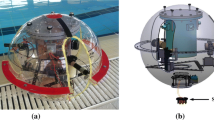Abstract
Conventional underwater intervention tasks are performed by underwater vehicles equipped with rigid multi-link arms. However, the movements of conventional mechanical arms exert reactive force on the vehicle platform due to their enormous bulk. Additionally, they cannot be used for small object recovery. In this paper, an ionic conducting polymer film (ICPF) actuator-based crayfish-inspired microrobot is designed and developed as a son robot for object recovery, which is connected to the amphibious father robot by copper wires. The crayfish-like son robot is used as the mechanical arm of the father–son robot system, which can grasp the small object especially in restricted spaces. The crayfish-inspired son robot actuated by ten ICPF actuators can realize underwater basic motions. The father robot can emit the son robot for object recovery. A proximity sensor is mounted in front of the microrobot between the two ICPF hands to implement the autonomous grasping motion. And we designed a blue LED-based underwater optical communication system to realize the communication between the father robot and the son robot for microrobot recovery. We carried out the experiments to confirm the basic operations of the microrobot, evaluate the performance of the communication system, and verify the blue LED tracking mechanism for microrobot recovery.

















Similar content being viewed by others
References
Abdelnour K, Stinchcombe A, Porfiri M, Zhang J, Childress S (2012) Wireless powering of ionic polymer metal composites toward hovering microswimmers. IEEE/ASME Trans Mechatron 17:924–935
Antonelli G, Chiaverini S, Sarkar N (2001) External force control for underwater vehicle–manipulator systems. IEEE Trans Robot Autom 17:931–938
Brundage H (2010) Designing a wireless underwater optical communication system. Master’s thesis, Massachusetts Institute of Technology, Cambridge, MA
Chase R, Pandya A (2012) A review of active mechanical driving principles of spherical robots. Robotics 1(1):3–23. doi:10.3390/robotics1010003
Chen Z, Shatara S, Tan X (2010) Modeling of biomimetic robotic fish propelled by an ionic polymer–metal composite caudal fin. IEEE/ASME Trans Mechatron 15(3):448–459
Cox WC, Simpson JA, Domizioli CP, Muth JF, Hughes BL (2008) An underwater optical communication system implementing Reed-Solomon channel coding. In: Proceedings of 2008 OCEANS conference. Boston, MA, pp 1–6
Cui Y, Sarkar N (2000) A unified force control approach to autonomous underwater manipulation. In: Proceedings 2000 IEEE international conference on robotics and automation (ICRA 2000). pp 255–266
De Novi G, Melchiorri C, Garcia JC, Sanz PJ, Ridao P, Oliver G (2009) A new approach for a reconfigurable autonomous underwater vehicle for intervention. In: Systems conference, 2009 3rd annual IEEE. pp 23–26
Dudek G, Giguere P, Prahacs C, Saunderson S, Sattar J, Torres-Mendez L, Jenkin M, German A, Hogue A, Ripsman A, Zacher J, Milios E, Liu H, Zhang P, Buehler M, Georgiades C (2007) AQUA: an amphibious autonomous robot. Computer 40(1):46–53
Gao B, Guo S (2010) Development of an infrared sensor-based wireless intelligent fish-like underwater microrobot. In: Proceedings of 2010 IEEE international conference on information and automation. Harbin, pp 1314–1318. 20–23 June 2010
Gao B, Guo S, Ye X (2011) Motion-control analysis of ICPF-actuated underwater biomimetic microrobots. Int. J. Mechatron Autom 1(2):79–89
Jun B, Lee P, Kim S (2008) Manipulability analysis of underwater robotic arms on ROV and application to task-oriented joint configuration. J Mech Sci Technol 22:887–894
Kim HJ (2011) Smart soft-morphing structure: design, manufacturing, and application. Ph.D. Thesis, School of Mechanical and Aerospace Engineering, Seoul National University
Li M, Guo S, Hirata H, Ishihara H (2015) Design and performance evaluation of an amphibious spherical robot. Robot Auton Syst 64:21–34. doi:10.1016/j.robot.2014.11.007
Lin X, Guo S, Tanaka K, Hata S (2010) Development and evaluation of a vectored water-jet-based spherical underwater vehicle. Inf Int Interdiscip J 13(6):1985–1998
Marani G, Choi S, Yuh J (2009) Underwater autonomous manipulation for intervention missions AUVs. Ocean Eng 36:15–23
Mohan S, Kim J (2012) Indirect adaptive control of an autonomous underwater vehicle–manipulator system for underwater manipulation tasks. Ocean Eng 54:233–243
Mohan S, Kim J (2015) Coordinated motion control in task space of an autonomous underwater vehicle–manipulator system. Ocean Eng 104:155–167
Shi L, Guo S, Li M, Mao S, Xiao N, Gao B, Song Z, Asaka K (2012) A novel soft biomimetic microrobot with two motion attitudes. Sensors 12(12):16732–16758
Tian B, Zhang F, Tan X (2013) Design and development of an LED-based optical communication system for autonomous underwater robots. In: Proceedings of 2013 IEEE/ASME international conference on advanced intelligent mechatronics, pp 1558–1563
Toshiba 4-legged nuclear plant inspection robot (2012) (Online). http://www.exponentialtimes.net/videos/toshiba-4-legged-nuclear-plant-inspection-robot/
Yeom SW, Oh IK (2009) A biomimetic jellyfish robot based on ionic polymer metal composite actuators. Smart Mater Struct 18, Paper No. 085002
Yu SC, Yuh J, Kim J (2013) Armless underwater manipulation using a small deployable agent vehicle connected by a smart cable. In: Ocean engineering. pp 149–159
Yue C, Guo S, Shi L (2015) Design and performance evaluation of a biomimetic microrobot for the father–son underwater intervention robotic system. Microsyst Technol. doi:10.1007/s00542-015-2457-z
Zhang S, Liang X, Xu L, Xu M (2013) Initial development of a novel amphibious robot with transformable fin-leg composite propulsion mechanisms. J Bionic Eng 10(4):434–445
Acknowledgments
This research is partly supported by National Natural Science Foundation of China (61375094), Key Research Program of the Natural Science Foundation of Tianjin (13JCZDJC26200), National High Tech. Research and Development Program of China (No. 2015AA043202), and SPS KAKENHI Grant Number 15K2120.
Author information
Authors and Affiliations
Corresponding author
Rights and permissions
About this article
Cite this article
Li, M., Guo, S., Guo, J. et al. Development of a biomimetic underwater microrobot for a father–son robot system. Microsyst Technol 23, 849–861 (2017). https://doi.org/10.1007/s00542-016-2817-3
Received:
Accepted:
Published:
Issue Date:
DOI: https://doi.org/10.1007/s00542-016-2817-3




